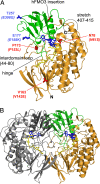Revealing the moonlighting role of NADP in the structure of a flavin-containing monooxygenase
- PMID: 18443301
- PMCID: PMC2373336
- DOI: 10.1073/pnas.0800859105
Revealing the moonlighting role of NADP in the structure of a flavin-containing monooxygenase
Abstract
Flavin-containing monooxygenases (FMOs) are, after cytochromes P450, the most important monooxygenase system in humans and are involved in xenobiotics metabolism and variability in drug response. The x-ray structure of a soluble prokaryotic FMO from Methylophaga sp. strain SK1 has been solved at 2.6-A resolution and is now the protein of known structure with the highest sequence similarity to human FMOs. The structure possesses a two-domain architecture, with both FAD and NADP(+) well defined by the electron density maps. Biochemical analysis shows that the prokaryotic enzyme shares many functional properties with mammalian FMOs, including substrate specificity and the ability to stabilize the hydroperoxyflavin intermediate that is crucial in substrate oxygenation. On the basis of their location in the structure, the nicotinamide ring and the adjacent ribose of NADP(+) turn out to be an integral part of the catalytic site being actively engaged in the stabilization of the oxygenating intermediate. This feature suggests that NADP(H) has a moonlighting role, in that it adopts two binding modes that allow it to function in both flavin reduction and oxygen reactivity modulation, respectively. We hypothesize that a relative domain rotation is needed to bring NADP(H) to these distinct positions inside the active site. Localization of mutations in human FMO3 that are known to cause trimethylaminuria (fish-odor syndrome) in the elucidated FMO structure provides a structural explanation for their biological effects.
Conflict of interest statement
The authors declare no conflict of interest.
Figures





References
-
- Cashman JR. Some distinctions between flavin-containing and cytochrome P450 monooxygenases. Biochem Biophys Res Commun. 2005;338:599–604. - PubMed
-
- van Berkel WJ, Kamerbeek NM, Fraaije MW. Flavoprotein monooxygenases, a diverse class of oxidative biocatalysts. J Biotechnol. 2006;124:670–689. - PubMed
-
- Ziegler DM. An overview of the mechanism, substrate specificities, and structure of FMOs. Drug Metab Rev. 2002;34:503–511. - PubMed
-
- Poulsen LL, Ziegler DM. The liver microsomal FAD-containing monooxygenase. J Biol Chem. 1979;254:6449–6455. - PubMed
-
- Beaty NB, Ballou DP. The reductive half-reaction of liver microsomal FAD-containing monooxygenase. J Biol Chem. 1981;256:4611–4618. - PubMed
Publication types
MeSH terms
Substances
Associated data
- Actions
- Actions
Grants and funding
LinkOut - more resources
Full Text Sources
Other Literature Sources
Molecular Biology Databases

